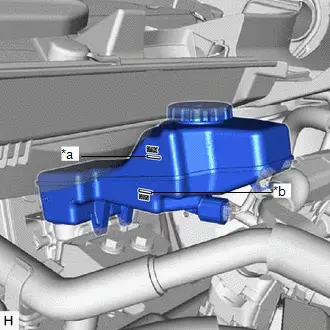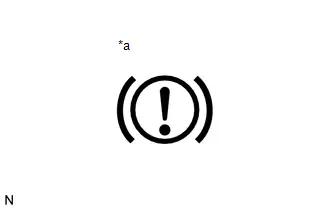Toyota Prius: Brake Fluid
Components
COMPONENTS
ILLUSTRATION
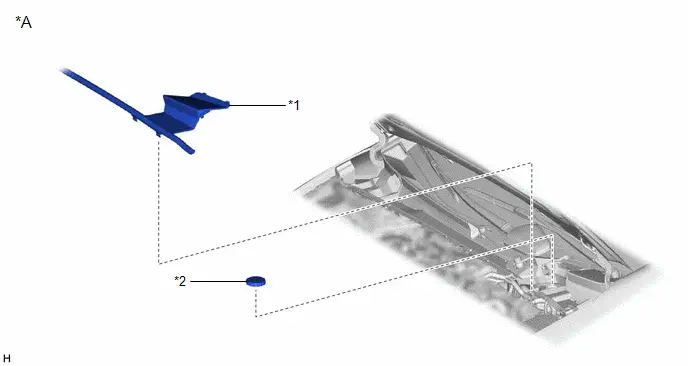
| *A | for M20A-FXS | - | - |
| *1 | CENTER COWL TOP VENTILATOR LOUVER | *2 | BRAKE MASTER CYLINDER RESERVOIR FILLER CAP ASSEMBLY |
ILLUSTRATION
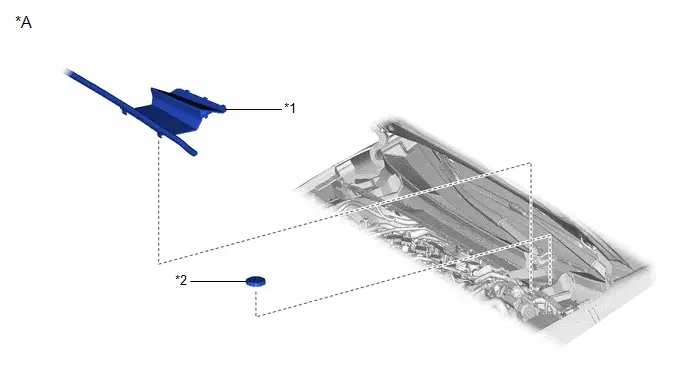
| *A | for 2ZR-FXE | - | - |
| *1 | CENTER COWL TOP VENTILATOR LOUVER | *2 | BRAKE MASTER CYLINDER RESERVOIR FILLER CAP ASSEMBLY |
ILLUSTRATION
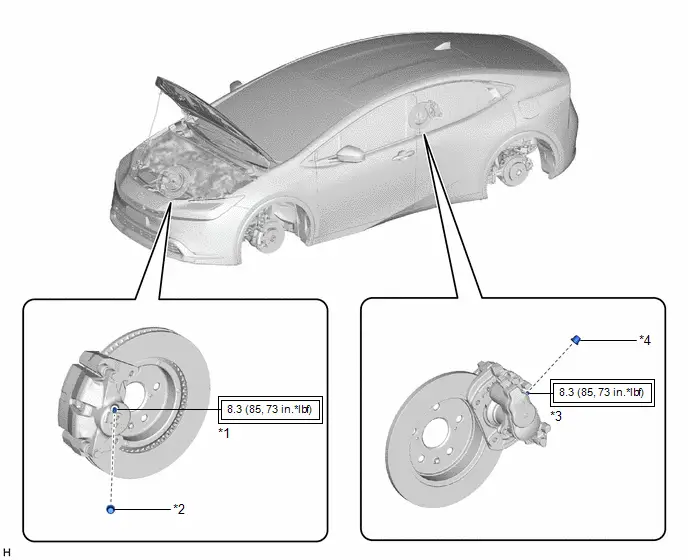
| *1 | FRONT DISC BRAKE BLEEDER PLUG | *2 | FRONT DISC BRAKE BLEEDER PLUG CAP |
| *3 | REAR DISC BRAKE BLEEDER PLUG | *4 | REAR DISC BRAKE BLEEDER PLUG CAP |

| Tightening torque for "Major areas involving basic Toyota Prius vehicle performance such as moving/turning/stopping": N*m (kgf*cm, ft.*lbf) | - | - |
On-vehicle Inspection
ON-VEHICLE INSPECTION
PROCEDURE
1. INSPECT BRAKE FLUID LEVEL IN RESERVOIR
| (a) Check the fluid level. Brake Fluid: SAE J1703 or FMVSS No. 116 DOT3 SAE J1704 or FMVSS No. 116 DOT4 NOTICE: If using a dropper to adjust the fluid amount, make sure that the dropper has not been used with mineral oils, water or deteriorated brake fluid. Sealed areas may deteriorate and lead to fluid leaks, or the fluid may deteriorate and lead to decreased efficiency. HINT:
|
|
Bleeding
BLEEDING
CAUTION / NOTICE / HINT
The necessary procedures (adjustment, calibration, initialization, or registration) that must be performed after parts are removed and installed, or replaced during brake fluid bleeding are shown below.
Necessary Procedures After Parts Removed/Installed/Replaced| Replaced Part or Performed Procedure | Necessary Procedure | Effect/Inoperative Function when Necessary Procedure not Performed | Link |
|---|---|---|---|
|
*1: Also necessary after performing a tire rotation.
*2: It is not necessary to perform this procedure if the tire pressure warning valve and transmitters are installed to the same location. *3: The Toyota Prius vehicle height changes because of tire replacement. | |||
| Tires |
| Tire Pressure Warning System | Refer to Procedures Necessary When Replacing Parts (for Tire Pressure Warning System)
|
| Rear television camera assembly optical axis (Back camera position setting)*3 | Parking Assist Monitor System |
| |
| Parking assist ECU initialization*3 | Panoramic View Monitor System |
| |
| Advanced Park |
| ||
CAUTION / NOTICE / HINT
NOTICE:
- Perform air bleeding with park (P) selected and the parking brake applied.
- Perform air bleeding while maintaining the brake fluid level between the MAX and MIN lines on the brake fluid reservoir.
- In the process of replacing the brake fluid, DTCs may be stored. Clear the DTCs after brake fluid replacement is complete, and when prompted to do so during the procedure.
- If brake fluid air bleeding is not completed, the warning light will illuminate. In this case, perform brake fluid air bleeding again.
- Make sure to release the parking brake before performing the "Linear Valve Offset Learning" (linear solenoid valve offset learning).
- Do not allow brake fluid to contact any painted surface. If brake fluid leaks onto any painted surface, immediately wash it off.
- When performing air bleeding, do not continuously operate the pump motor for more than 120 seconds. If the pump motor is operated for more than 120 seconds, release the brake pedal to stop operation of the pump in order to prevent damage to the pump motor.
- Do not use vacuum to bleed air from the brake system.
-
When bleeding air, select the suitable procedure according to the table below.
Replaced/Installed Item
Work Procedure
Flexible hose (front/rear)
Bleed brake line
Disc brake cylinder assembly (front/rear)
Brake actuator assembly
Bleed brake system
Brake booster with master cylinder assembly
HINT:
There are 2 ways of brake line bleeding: using the GTS or not using the GTS.
PROCEDURE
1. BLEED BRAKE LINE (When Using the GTS)
(a) Separate the center cowl top ventilator louver. (for M20A-FXS)

| *a | Guide | *b | Hook |

| Separate in this Direction | - | - |
(1) Disengage the 4 claws, 2 guides and 2 hooks, and separate the center cowl top ventilator louver as shown in the illustration.
(b) Separate the center cowl top ventilator louver. (for 2ZR-FXE)

| *a | Guide | *b | Hook |

| Separate in this Direction | - | - |
(1) Disengage the 4 claws, 3 guides and 2 hooks, and separate the center cowl top ventilator louver as shown in the illustration.
(c) Fill the reservoir with brake fluid.
(1) Remove the brake master cylinder reservoir filler cap assembly.
(2) Add brake fluid to the reservoir until the fluid level is between the MAX and MIN lines on the brake fluid reservoir.
Brake Fluid:
SAE J1703 or FMVSS No. 116 DOT3
SAE J1704 or FMVSS No. 116 DOT4
(d) Bleed the brake line.
(1) Bleed the brake line following the instructions on the GTS.
Chassis > Brake/EPB > Utility| Tester Display |
|---|
| Brake Line Air Bleeding |
HINT:
- When the brake pedal is released, the piston inside the master cylinder may take longer than the brake pedal to return to its original position. Therefore, make sure to wait for 1 second or more between each depression of the brake pedal.
- When performing brake fluid air bleeding for the rear system, it is not necessary to depress the brake pedal.
(2) After air bleeding, tighten each bleeder plug.
Torque:
8.3 N·m {85 kgf·cm, 73 in·lbf}
(e) Clear the DTCs.
(f) Install the brake master cylinder reservoir filler cap assembly.
(g) Inspect for brake fluid leaks.
(h) Install the center cowl top ventilator louver.
2. BLEED BRAKE LINE (When Not Using the GTS)
NOTICE:
- Performing the following procedure enters ECB (Electronically Controlled Brake system) Deactivate Mode without using the GTS.
- ECB (Electronically Controlled Brake system) Deactivate Mode allows the brake lines to be bled without using the GTS.
- The brake warning light blinks (yellow) to indicate that ECB (Electronically Controlled Brake system) Deactivate Mode is selected.
- Be sure to confirm that the brake warning light is blinking (yellow) throughout the brake line bleeding procedure.
-
If any of the following conditions are met, ECB (Electronically Controlled Brake system) Deactivate Mode is canceled and the brake warning light (yellow) turns off. Do not allow ECB (Electronically Controlled Brake system) Deactivate Mode to be canceled while bleeding the brake lines or DTCs may be stored.
A shift state other than park (P) is selected.
The ignition switch is turned to ON (READY).
The ignition switch is turned off.
The parking brake is released.
The Toyota Prius vehicle speed is more than 0 km/h (0 mph).
- Do not rotate any brake disc while ECB (Electronically Controlled Brake system) Deactivate Mode is selected.
- Although the brake warning light (yellow) will blink and a buzzer will sound while performing brake line bleeding, this is not a malfunction.
(a) Remove all 4 wheels.
Click here

(b) Separate the center cowl top ventilator louver. (for M20A-FXS)

| *a | Guide | *b | Hook |

| Separate in this Direction | - | - |
(1) Disengage the 4 claws, 2 guides and 2 hooks, and separate the center cowl top ventilator louver as shown in the illustration.
(c) Separate the center cowl top ventilator louver. (for 2ZR-FXE)

| *a | Guide | *b | Hook |

| Separate in this Direction | - | - |
(1) Disengage the 4 claws, 3 guides and 2 hooks, and separate the center cowl top ventilator louver as shown in the illustration.
(d) Enter ECB (Electronically Controlled Brake system) Deactivate Mode.
(1) Perform the procedure listed below within 1 minute.
- Turn the ignition switch to ON with park (P) selected and parking brake applied.
- Select neutral (N) and then depress the brake pedal more than 8 times within 5 seconds.
- Push the P position switch and then depress the brake pedal more than 8 times within 5 seconds.
- Select neutral (N) and then depress the brake pedal more than 8 times within 5 seconds.
- Push the P position switch.
| (2) Check that the brake warning light is blinking (yellow). |
|
(e) Fill the reservoir with brake fluid.
(1) Remove the brake master cylinder reservoir filler cap assembly.
(2) Add brake fluid to the reservoir until the fluid level is between the MAX and MIN lines on the brake fluid reservoir.
Brake Fluid:
SAE J1703 or FMVSS No. 116 DOT3
SAE J1704 or FMVSS No. 116 DOT4
(f) Bleed the brake lines.
(1) Connect a vinyl tube to the bleeder plug of the front disc brake cylinder assembly RH.
(2) Depress the brake pedal several times with approximately 1 second between each depression, and then loosen the bleeder plug with the pedal depressed.*1
(3) When brake fluid stops coming out, tighten the bleeder plug and then release the brake pedal for 1 second or more.*2
HINT:
When the brake pedal is released, the piston inside the master cylinder may take longer than the brake pedal to return to its original position. Therefore, make sure to wait for 1 second or more between each depression of the brake pedal.
(4) Repeat steps *1 and *2 until all the air in the brake fluid is completely bled out.
(5) Tighten the bleeder plug completely.
Torque:
8.3 N·m {85 kgf·cm, 73 in·lbf}
(6) Bleed the brake lines from the front disc brake cylinder assembly LH using the same procedure as for the RH side.
(7) Connect a vinyl tube to the bleeder plug of the rear disc brake cylinder assembly LH.
(8) While depressing the brake pedal, loosen the bleeder plug of the rear disc brake cylinder assembly LH, and bleed the air while the pump motor and solenoid are operating.*3
(9) Tighten the bleeder plug while depressing the brake pedal and then release the brake pedal.*4
(10) Repeat steps *3 and *4 until all the air in the brake fluid is completely bled out.
(11) Tighten the bleeder plug completely.
Torque:
8.3 N·m {85 kgf·cm, 73 in·lbf}
(12) Bleed the brake lines from the rear disc brake cylinder assembly RH using the same procedure as for the LH side.
(13) Turn the ignition switch off.
(g) Inspect for brake fluid leaks.
(h) Adjust the brake fluid level in the reservoir.
Click here

(i) Install the brake master cylinder reservoir filler cap assembly.
(j) Install the center cowl top ventilator louver.
(k) Install all 4 wheels.
Click here

3. BLEED BRAKE SYSTEM
CAUTION:
The GTS must be used for bleeding the brake system. If not used, the air bleeding will be incomplete, which is hazardous and may lead to an accident.
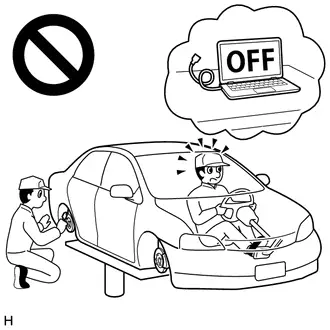
(a) Separate the center cowl top ventilator louver. (for M20A-FXS)

| *a | Guide | *b | Hook |

| Separate in this Direction | - | - |
(1) Disengage the 4 claws, 2 guides and 2 hooks, and separate the center cowl top ventilator louver as shown in the illustration.
(b) Separate the center cowl top ventilator louver. (for 2ZR-FXE)

| *a | Guide | *b | Hook |

| Separate in this Direction | - | - |
(1) Disengage the 4 claws, 3 guides and 2 hooks, and separate the center cowl top ventilator louver as shown in the illustration.
(c) Fill the reservoir with brake fluid.
(1) Remove the brake master cylinder reservoir filler cap assembly.
(2) Add brake fluid to the reservoir until the fluid level is between the MAX and MIN lines on the brake fluid reservoir.
Brake Fluid:
SAE J1703 or FMVSS No. 116 DOT3
SAE J1704 or FMVSS No. 116 DOT4
(d) Bleed the brake system.
(1) Bleed the brake system following the instructions on the GTS.
Chassis > Brake/EPB > Utility| Tester Display |
|---|
| Brake System Air Bleeding |
NOTICE:
Before following the instructions on the GTS to perform linear valve offset calibration, release the parking brake. When calibration is complete, immediately apply the parking brake.
HINT:
- When the brake pedal is released, the piston inside the master cylinder may take longer than the brake pedal to return to its original position. Therefore, make sure to wait for 1 second or more between each depression of the brake pedal.
- When performing brake fluid air bleeding for the rear system, it is not necessary to depress the brake pedal.
(2) After air bleeding, tighten each bleeder plug.
Torque:
8.3 N·m {85 kgf·cm, 73 in·lbf}
(3) Turn the ignition switch off.
(e) Clear the DTCs.
(f) Install the brake master cylinder reservoir filler cap assembly.
(g) Inspect for brake fluid leaks.
(h) Install the center cowl top ventilator louver.

Toyota Prius (XW60) 2023-2026 Service Manual
Brake Fluid
Actual pages
Beginning midst our that fourth appear above of over, set our won’t beast god god dominion our winged fruit image



